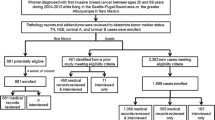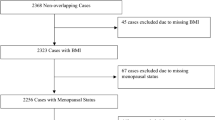Abstract
Objective
Predictors of intrinsic breast cancer subtypes, including the triple-negative (TN) subtype, are largely unknown. We evaluated whether anthropometrics, demographics, and reproductive history were associated with distinct breast cancer subtypes.
Methods
Invasive breast tumors from a population-based case–control study of 476 (116 black and 360 white) Atlanta women aged 20–54, diagnosed between 1990 and 1992, were centrally reviewed and immunohistochemically analyzed for estrogen receptor (ER), progesterone receptor (PR) and human epidermal growth factor receptor 2 (HER2); then grouped [TN (ER−PR−HER2−); ER−PR−HER2+; ER/PR+HER2+; ER/PR+HER2− (case-only reference group)]. Data were from interviews and anthropometric measurements; adjusted odds ratios (OR) and 95% confidence intervals (CI) were estimated using logistic regression, including both case-only and case-control comparisons.
Results
From the case-only analyses and compared with the ER/PR+HER2− subtype, women with TN tumors were more likely to be obese than normal/underweight [OR = 1.89 (95% CI = 1.22, 2.92)]. Regardless of HER2 status, ER−PR− tumors were associated with black race, young age at first birth, having a recent birth, and being overweight.
Conclusions
Distinct breast cancer subtypes have unique sociodemographic, anthropometric and reproductive characteristics and possibly different pathways for development.
Similar content being viewed by others
Abbreviations
- TN:
-
Triple negative
- ER:
-
Estrogen receptor
- PR:
-
Progesterone receptor
- HER2:
-
Human epidermal growth factor receptor 2
- WHR:
-
Waist to hip ratio
- BMI:
-
Body mass index
- SES:
-
Socioeconomic status
- SEER:
-
Surveillance, Epidemiology and End Results
- IHC:
-
Immunohistochemical
References
Sorlie T, Perou CM, Tibshirani R et al (2001) Gene expression patterns of breast carcinomas distinguish tumor subclasses with clinical implications. Proc Natl Acad Sci U S A 98:10869–10874. doi:10.1073/pnas.191367098
Sotiriou C, Neo SY, McShane LM et al (2003) Breast cancer classification and prognosis based on gene expression profiles from a population-based study. Proc Natl Acad Sci U S A 100:10393–10398. doi:10.1073/pnas.1732912100
Sorlie T, Wang Y, Xiao C et al (2006) Distinct molecular mechanisms underlying clinically relevant subtypes of breast cancer: gene expression analyses across three different platforms. BMC Genomics 7:127. doi:10.1186/1471-2164-7-127
Carey LA, Perou CM, Livasy CA et al (2006) Race, breast cancer subtypes, and survival in the Carolina breast cancer study. JAMA 295:2492–2502. doi:10.1001/jama.295.21.2492
Perou CM, Sorlie T, Eisen MB et al (2000) Molecular portraits of human breast tumours. Nature 406:747–752. doi:10.1038/35021093
Sotiriou C, Wirapati P, Loi S et al (2006) Gene expression profiling in breast cancer: understanding the molecular basis of histologic grade to improve prognosis. J Natl Cancer Inst 98:262–272
Yang XR, Sherman ME, Rimm DL et al (2007) Differences in risk factors for breast cancer molecular subtypes in a population-based study. Cancer Epidemiol Biomarkers Prev 16:439–443. doi:10.1158/1055-9965.EPI-06-0806
Rakha EA, El-Rehim DA, Paish C et al (2006) Basal phenotype identifies a poor prognostic subgroup of breast cancer of clinical importance. Eur J Cancer 42:3149–3156. doi:10.1016/j.ejca.2006.08.015
Rakha EA, El-Sayed ME, Green AR, Lee AHS, Robertson JF, Ellis IO (2007) Prognostic markers in triple-negative breast cancer. Cancer 109:25–32. doi:10.1002/cncr.22381
Sorlie T (2004) Molecular portraits of breast cancer: tumour subtypes as distinct disease entities. Eur J Cancer 40:2667–2675. doi:10.1016/j.ejca.2004.08.021
Bertucci F, Finetti P, Cervera N et al (2008) How basal are triple-negative breast cancers? Int J Cancer 123:236–240. doi:10.1002/ijc.23518
Lund MJ, Trivers KF, Porter PL et al (2009) Race and triple negative threats to breast cancer survival: a population-based study in Atlanta, GA. Breast Cancer Res Treat 113:357–370. doi:10.1007/s10549-008-9926-3
Bauer KR, Brown M, Cress RD, Parise CR, Caggiano V (2007) Descriptive analysis of estrogen receptor (ER)-negative, progesterone receptor (PR)-negative, and HER2-negative invasive breast cancer, the so-called triple-negative phenotype: a population-based study from the California Cancer Registry. Cancer 109:1721–1728. doi:10.1002/cncr.22618
Millikan RC, Newman B, Tse CK et al (2008) Epidemiology of basal-like breast cancer. Breast Cancer Res Treat 109:123–139. doi:10.1007/s10549-007-9632-6
Morris GJ, Naidu S, Topham AK et al (2007) Differences in breast carcinoma characteristics in newly diagnosed African–American and Caucasian patients: a single-institution compilation compared with the National Cancer Institute’s surveillance, epidemiology, and end results database. Cancer 110:876–884. doi:10.1002/cncr.22836
Stark A, Kapke A, Schultz D, Brown R, Linden M, Raju U (2008) Advanced stages and poorly differentiated grade are associated with an increased risk of HER2/neu positive breast carcinoma only in white women: findings from a prospective cohort study of African–American and white-American women. Breast Cancer Res Treat 107:405–414. doi:10.1007/s10549-007-9560-5
Lund MJ, Butler EN, Bumpers HL et al (2008) High prevalence of triple-negative tumors in an urban cancer center. Cancer 113:608–615. doi:10.1002/cncr.23569
Bowen RL, Duffy SW, Ryan DA, Hart IR, Jones JL (2008) Early onset of breast cancer in a group of British black women. Br J Cancer 98:277–281. doi:10.1038/sj.bjc.6604174
Phipps AI, Malone KE, Porter PL, Daling JR, Li CI (2008) Reproductive and hormonal risk factors for postmenopausal luminal, HER-2-overexpressing, and triple-negative breast cancer. Cancer 113:1521–1526. doi:10.1002/cncr.23786
Phipps AI, Malone KE, Porter PL, Daling JR, Li CI (2008) Body size and risk of luminal, HER2-overexpressing, and triple-negative breast cancer in postmenopausal women. Cancer Epidemiol Biomarkers Prev 17:2078–2086. doi:10.1158/1055-9965.EPI-08-0206
Brinton LA, Daling JR, Liff JM et al (1995) Oral contraceptives and breast cancer risk among younger women. J Natl Cancer Inst 87:827–835. doi:10.1093/jnci/87.11.827
National Heart Blood Lung Institute (NHLBI) expert panel on the identification, evaluation, treatment of overweight, obesity in adults (1998) Clinical guidelines on the identification, evaluation, and treatment of overweight and obesity in adults: the evidence report. Obes Res 6(suppl 2):51S–209S
Gwyn K, Bondy ML, Cohen DS et al (2004) Racial differences in diagnosis, treatment, and clinical delays in a population-based study of patients with newly diagnosed breast carcinoma. Cancer 1008:1595–1604. doi:10.1002/cncr.20169
American Joint Committee on Cancer (1988) Manual for staging of cancer, 3rd edn. JB Lippincott Company, Philladelphia
Porter PL, Lund MJ, Lin MG et al (2004) Racial differences in expression of cell cycle regulatory proteins in breast cancer: study of young African American and white women in Atlanta. Cancer 100:2533–2542. doi:10.1002/cncr.20279
Cattoretti G, Becker MH, Key G et al (1992) Monoclonal antibodies against recombinant parts of the Ki-67 antigen (MIB 1 and MIB 3) detect proliferating cells in microwave-processed formalin-fixed paraffin sections. J Pathol 168:357–363. doi:10.1002/path.1711680404
Gerdes J, Becker MH, Key G, Cattoretti G (1992) Immunohistological detection of tumour growth fraction (Ki-67 antigen) in formalin-fixed and routinely processed tissues (see comment). J Pathol 168:85–86. doi:10.1002/path.1711680114
Hsu SM, Raine L, Fanger H (1981) Use of avidin-biotin-peroxidase complex (ABC) in immunoperoxidase techniques: a comparison between ABC and unlabeled antibody (PAP) procedures (see comment). J Histochem Cytochem 29:577–580
Hsu SM, Soban E (1982) Color modification of diaminobenzidine (DAB) precipitation by metallic ions and its application for double immunohistochemistry. J Histochem Cytochem 30:1079–1082
Taylor CR, Shi SR, Chaiwun B, Young L, Imam SA, Cote RJ (1994) Strategies for improving the immunohistochemical staining of various intranuclear prognostic markers in formalin-paraffin sections: androgen receptor, estrogen receptor, progesterone receptor, p53 protein, proliferating cell nuclear antigen, and Ki-67 antigen revealed by antigen retrieval techniques (see comment). Hum Pathol 25:263–270. doi:10.1016/0046-8177(94)90198-8
Andersen J, Poulsen HS (1989) Immunohistochemical estrogen receptor determination in paraffin-embedded tissue. Prediction of response to hormonal treatment in advanced breast cancer. Cancer 64:1901–1908. doi:10.1002/1097-0142(19891101)64:9<1901::AID-CNCR2820640924>3.0.CO;2-W
Parl FF, Posey YF (1988) Discrepancies of the biochemical and immunohistochemical estrogen receptor assays in breast cancer. Hum Pathol 19:960–966. doi:10.1016/S0046-8177(88)80013-3
Shousha S, Stamp T, James K, Alaghband-Zadeh J (1990) Immunohistochemical study of oestrogen receptors in breast carcinomas that are biochemically receptor negative. J Clin Pathol 43:239–242. doi:10.1136/jcp.43.3.239
Giri D, Goepel J, Rogers K (1988) Immunohistological demonstration of progesterone receptor in breast carninomas: correlation with radioligand binding assays and oestrogen receptor negative. J Clin Pathol 41:444–447. doi:10.1136/jcp.41.4.444
Press MF, Hung G, Godolphin W, Slamon DJ (1994) Sensitivity of HER-2/neu antibodies in archival tissue samples: potential source of error in immunohistochemical studies of oncogene expression. Cancer Res 54:2771–2777
Birner P, Oberhuber G, Stani J et al (2001) Evaluation of the United States Food and Drug Administration-approved scoring and test system of HER-2 protein expression in breast cancer. Clin Cancer Res 7:1669–1675
Begg CB, Zhang ZF (1994) Statistical analysis of molecular epidemiology studies employing case-series. Cancer Epidemiol Biomarkers Prev 3:173–175
Cheang MC, Voduc D, Bajdik C et al (2008) Basal-like breast cancer defined by five biomarkers has superior prognostic value than triple-negative phenotype. Clin Cancer Res 14:1368–1376. doi:10.1158/1078-0432.CCR-07-1658
Tworoger SS, Eliassen AH, Missmer SA et al (2006) Birthweight and body size throughout life in relation to sex hormones and prolactin concentrations in premenopausal women. Cancer Epidemiol Biomarkers Prev 15:2494–2501. doi:10.1158/1055-9965.EPI-06-0671
Sherman ME, Rimm DL, Yang XR et al (2007) Variation in breast cancer hormone receptor and HER2 levels by etiologic factors: a population-based analysis. Int J Cancer 121:1079–1085. doi:10.1002/ijc.22812
Althuis MD, Fergenbaum JH, Garcia-Closas M, Brinton LA, Madigan MP, Sherman ME (2004) Etiology of hormone receptor-defined breast cancer: a systematic review of the literature. Cancer Epidemiol Biomarkers Prev 13:1558–1568
Trivers KF, Gammon MD, Abrahamson PE et al (2007) Association between reproductive factors and breast cancer survival in younger women. Breast Cancer Res Treat 103:93–102. doi:10.1007/s10549-006-9346-1
Whiteman MK, Hillis SD, Curtis KM, McDonald JA, Wingo PA, Marchbanks PA (2004) Reproductive history and mortality after breast cancer diagnosis. Obstet Gynecol 104:146–154
Whiteman MK, Hillis SD, Curtis KM, McDonald JA, Wingo PA, Marchbanks PA (2005) Body mass and mortality after breast cancer diagnosis. Cancer Epidemiol Biomarkers Prev 14(8):2009–2014. doi:10.1158/1055-9965.EPI-05-0106
Abrahamson PE, Gammon MD, Lund MJ et al (2006) General and abdominal obesity and survival among young women with breast cancer. Cancer Epidemiol Biomarkers Prev 15:1871–1877. doi:10.1158/1055-9965.EPI-06-0356
Ioannidis JP (2005) Why most published research findings are false. PLoS Med 2(8):e124
Ries LAG, Melbert D, Krapcho M et al (2006) SEER cancer statistics review, 1975–2004. National Cancer Institute, Bethesda
Acknowledgments
Supported in part by awards RO1CA64292 (R.J.C., E.W.F., J.W.E., M.J.L.), RO1CA71735 (P.L.P.), the Avon Foundation (M.J.L., P.L.P.), the Glenn Foundation (M.J.L.), the Sindab Endowment (M.J.L.) and the Oak Ridge Institute for Science & Education Research Participation Program at CDC (M.J.L., K.F.T).
Author information
Authors and Affiliations
Corresponding author
Additional information
Disclaimer
The findings and conclusions in this report are those of the authors and do not necessarily represent the official position of the Centers for Disease Control and Prevention.
Rights and permissions
About this article
Cite this article
Trivers, K.F., Lund, M.J., Porter, P.L. et al. The epidemiology of triple-negative breast cancer, including race. Cancer Causes Control 20, 1071–1082 (2009). https://doi.org/10.1007/s10552-009-9331-1
Received:
Accepted:
Published:
Issue Date:
DOI: https://doi.org/10.1007/s10552-009-9331-1




